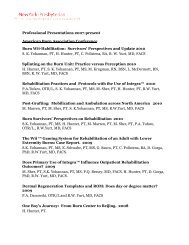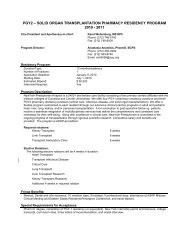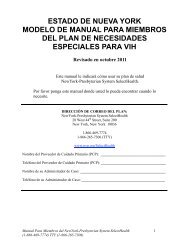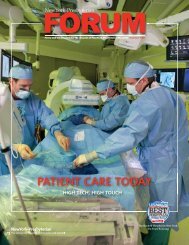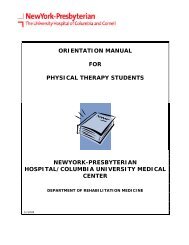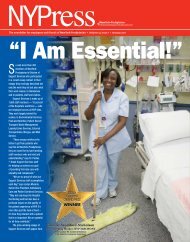SACROILIITIS
SACROILIITIS
SACROILIITIS
You also want an ePaper? Increase the reach of your titles
YUMPU automatically turns print PDFs into web optimized ePapers that Google loves.
Epidemiology• First described as a source of pain by Goldthwaite andOsgood in 1905• Accounts for 15-25% of axial low back pain• May rise to 20-80% in pregnant women
SI Joint Anatomy• Largest axial joint• Mainly supportive• Sacral surface-hyaline cartilage• Ilial surface-fibrocartilage• Great variability in size, shape, contour
SI Joint Anatomy• Support structure, multiple wide ligaments• Biomechanical studies: 2-18º• Superior 2/3 fibro-cartilaginous, caudal 1/3 true joint• Variability• Innervation is from dorsalprimary rami of L5-S3• Some authors suggest L4(or even L3) and S4 contribute
Innervation©Medscape
Neuroanatomy
Neuroanatomy
Innervation• Extremely variablelocation• Forms a mesh medial toSI joint• Dorsal Ramus of L5• Lateral branches S1 –S3(+/- L4, S4)
Differential• Discogenic pain• Painful facet arthropathy• Superficial structures• Ligaments• Tendons• Muscles
Etiology• Mechanical dysfunction• Inflammation• Infection• Trauma• Degeneration• Metabolic• Neoplastic
Diagnosis• Diagnosis• Primarily by history and physical• Can incorporate imaging (X-Ray/CT/MRI) although thereare many false positives and negatives• Diagnostic/therapeutic blocks• Symptoms• Low back pain• Radiation to buttocks, groin, post. thigh (rarely past knee)• Often exacerbated by prolonged standing/sitting• Physical findings• Poor inter-examiner reliability• Can enhance specificity and sensitivity by combining tests
Physical ExamPatrick’s/FABERGaenslenDistractionCompressionThigh thrust
Physical Exam,cont’dYoemann’s testShear testGillet’s test (stork test)Raj, 2008
DiagnosticInjections• Local anesthetic alone• Duration of relief concordant with that of anesthetic action• Proper technique important• Single vs. 2 or more injections on separate occasions• LA’s of varying duration to help validate dx• Local plus steroid• Diagnostic and therapeutic• Longer effect duration• Cannot test duration concordance• Caveats• Gold standard but not validated• Extravasation of injectate very common
Sacroiliac JointInjections
TreatmentSurgical fusionRadiofrequency denervationIntra-articular injectionAnti-inflammatoriesPT
Physical Therapy• Used extensively• Home exercises• Inserts for leg-length discrepancies• Osteopathic/chiropractic manipulation mayreduce pain, improve mobility• Stabilization with bracing• Pelvic stabilization exercises
spine-health.comPhysical Therapy
Therapeutic SIInjection• Technique identical to diagnostic injection• Addition of steroid• Duration of effect difficult to predict• Some support in literature, no RCT’s• Many show prolonged benefit (6mo-1yr)• Many practitioners use as combination dx/tx
SI Injection: TheLiteratureCohen, 2005
SI Injection: TheLiteratureCohen, 2005
PeriarticularInjection• Hypothesize that posterior interosseous ligamentscontribute more to SIJ pain than joint itself• Middle section-includes axial posterior interosseousligament which is susceptible to degenerative changes• Some studies-articular vs. articular + periarticulargreaterimprovement w/latter
RadiofrequencyAblation• Recall innervation of SI joint
Innervation©Medscape
RadiofrequencyAblation• Recall innervation of SI joint• Predominantly dorsal innervation
Innervation©Medscape
RadiofrequencyAblation• Recall innervation of SI joint• Predominantly dorsal innervation• From L5 dorsal ramus, S1-3 lateralbranches
RadiofrequencyAblation• Precede by diagnostic injection• Must cover L5-S3 dorsal primary rami• Bipolar RF energy to create strip lesion• “Leapfrog” technique OR• Single, multi-electrode probeRathmell,, 2006
Burnham, 2007Leapfrog Technique
Single Probe Technique• 3 electrodes on 1 probe• Single puncture (plus one for L5)• Orientation parallel to sacrum• 3 monopolar and 2 bipolarlesions
RFA-Caveats• Does not effect ventral innervation if present• Lesioned nerves innervate other structures• Ligaments• Muscle• Muscle spasm post-procedure
Patient Experience• Sacroiliac Joint Injection• Done in fluoroscopy suite• Patient prone• Local anesthetic with small 30g needle• About 10 minutes• Radiofrequency Ablation• IV sedation and local• About 1hr• Post-procedure muscle spasm common, easily treatedwith muscle relaxants (diazepam)




